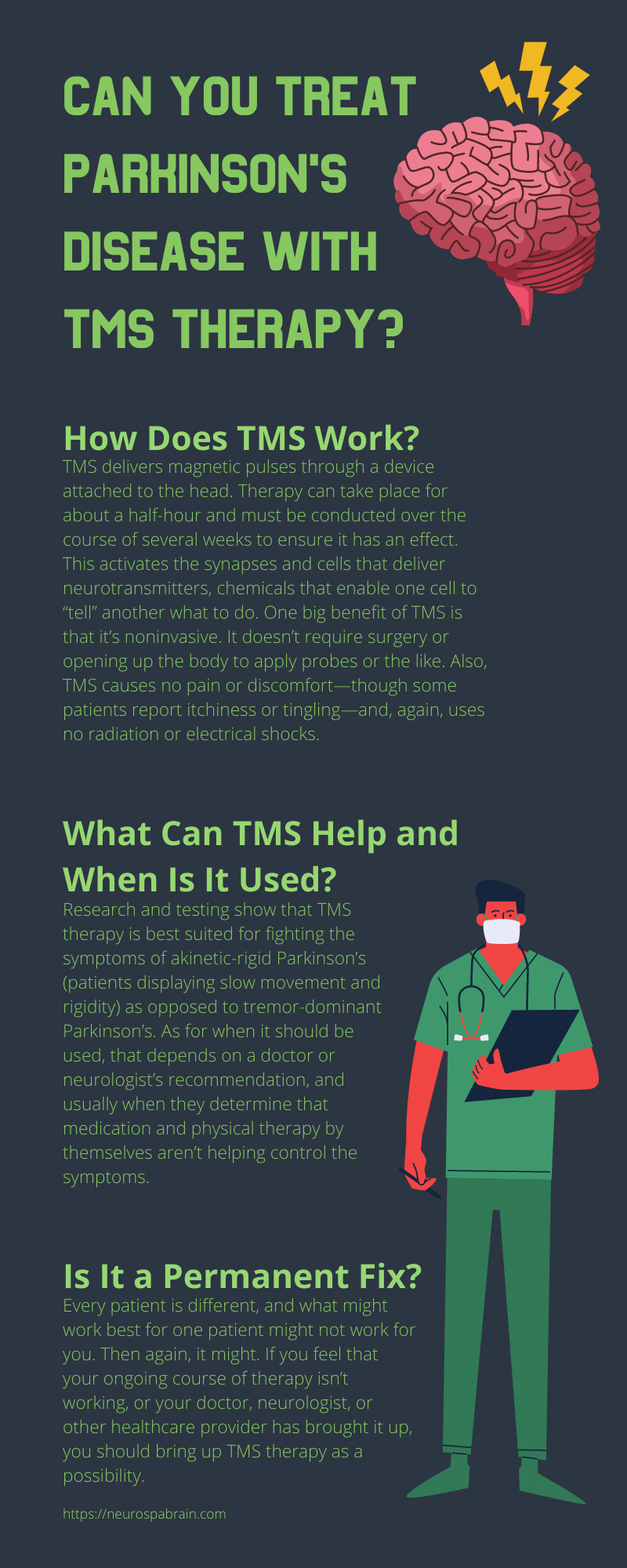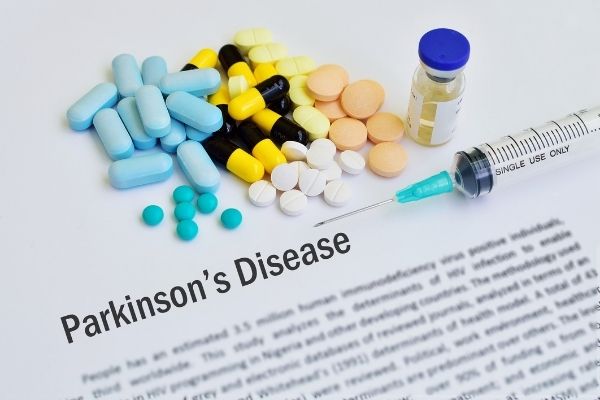Can you treat Parkinson’s disease with TMS therapy? It’s an excellent question and most easily answered, yes, yes you can. However, it must be remembered that TMS, or transcranial magnetic stimulation therapy, is strictly that—therapy. Thus far, there is no cure for Parkinson’s, but research and testing continue, and some strides have been made in the treatment of the disease. In the meantime, there are medications, physical therapy, and other treatments proven to help Parkinson’s patients abate their symptoms and live longer and more comfortable lives.
In more recent years, TMS therapy for Parkinson’s has been shown to help Parkinson’s patients with controlling or diminishing such classic symptoms as freezing, tremors, and rigidity through delivering pulses to the parts of the brain related to these symptoms and their usual attendant movements. But TMS isn’t a panacea, and it seems to have a greater effect on certain types of Parkinson’s than on others. Regardless, results have been promising. With further study and testing, we may discover other ways TMS can help Parkinson’s and other nerve and brain disorders like seizures, anxiety, depression, and more. Here’s what we know so far and what we hope to learn more about in the future.
How Does TMS Work?
While there is absolutely no delivery of electric shocks or the like, it might be simpler to think of TMS as a “jumpstart” for the brain. As mentioned, TMS delivers magnetic pulses through a device attached to the head. Therapy can take place for about a half-hour and must be conducted over the course of several weeks to ensure it has an effect. That said, the pulses stimulate parts of the brain that become inactive due to Parkinson’s or other conditions. This activates the synapses and cells that deliver neurotransmitters, chemicals that enable one cell to “tell” another what to do. Some have stated that TMS can help “regrow” these connections and revitalize the brain.
One big benefit of TMS is that it’s noninvasive. It doesn’t require surgery or opening up the body to apply probes or the like. Also, TMS causes no pain or discomfort—though some patients report itchiness or tingling—and, again, uses no radiation or electrical shocks. With TMS, signals that might have been blocked or remained undelivered are able to get through and alleviate the symptoms affecting the body’s motion. This can open greater possibilities to keep the body active and healthy and able to fight the progression of Parkinson’s disease.
What Can TMS Help and When Is It Used?
Can you treat Parkinson’s disease with TMS therapy? Research and testing show that TMS therapy is best suited for fighting the symptoms of akinetic-rigid Parkinson’s (patients displaying slow movement and rigidity) as opposed to tremor-dominant Parkinson’s. Why? It’s not yet entirely clear, but the prospects are promising. As for when it should be used, that depends on a doctor or neurologist’s recommendation, and usually when they determine that medication and physical therapy by themselves aren’t helping control the symptoms.
Other things that make a patient a candidate for TMS therapy for Parkinson’s include symptoms severely cutting into a patient’s ability to function and enjoy life, as well as an increase in involuntary movements and tremors. If the amount of medication a patient takes each day has reached four or more doses, that’s another red flag for the use of TMS treatment. As a side note, TMS isn’t used alone, and is most often combined with other therapies and treatments. Transcranial magnetic stimulation is usually combined with aerobic activity to help increase strength as well as to test the connection between the brain and the other parts of the body.
Is It a Permanent Fix?
Sadly, no. Nor do we have a fixed time span for how long the treatment, when it is effective, lasts. But that doesn’t mean that when the therapy works the positive effects won’t last for a while. Research is ongoing regarding Parkinson’s reaction to TMS treatment. So far, though, when used to treat depression, anxiety, and other ailments caused by neurodegenerative disorders, results have lasted anywhere from six months to a year, with most patients enjoying improved symptoms or even remission.
But again, Parkinson’s disease operates under a different set of conditions and parameters. Everyone is different, and so the results may be different as well. But thus far there appears to be hope for TMS as a therapy for Parkinson’s. Several studies have shown, however, that when subjected to transcranial magnetic stimulation therapy, most patients subjected to TMS therapy (as opposed to a placebo) showed much improvement without any side effects or long-term effects if they experienced minor itchiness, pain, light-headedness, dizziness, and the like. Also, both high-frequency and low-frequency seemed effective in treatment and had effects that lasted for some time. As for side effects, despite concerns, the use of TMS therapy for Parkinson’s disease has been shown to have absolutely no effect on memory or cognitive abilities.
What’s Next for TMS and You?
If you’re a Parkinson’s patient, the biggest question on your mind is whether transcranial magnetic therapy is right for you. Every patient is different, and what might work best for one patient might not work for you. Then again, it might. If you feel that your ongoing course of therapy isn’t working, or your doctor, neurologist, or other healthcare provider has brought it up, you should bring up TMS therapy as a possibility. They may suggest a new course of medication or other therapy first, but it never hurts to ask about it. If nothing else, you’ll both be aware that there are options and alternatives that may provide a more satisfying and longer lasting period of reduced symptoms and diminished or eliminated side effects.
Don’t be shy about bringing up TMS therapy for Parkinson’s at your next doctor or neurologist visit. Your treatment is a working arrangement with your physicians, and you should all be willing to collaborate and share information during its course!



